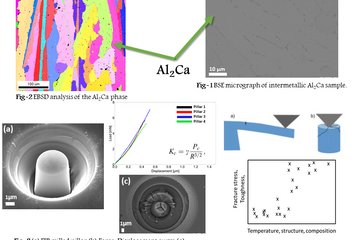All genres
81.
Journal Article
Understanding Grain Boundary Electrical Resistivity in Cu: The Effect of Boundary Structure. ACS Nano 15 (10), pp. 16607 - 16615 (2021)
82.
Journal Article
Aluminum depletion induced by co-segregation of carbon and boron in a bcc-iron grain boundary. Nature Communications 12, 6008 (2021)
83.
Journal Article
Influence of substrates and e-beam evaporation parameters on the microstructure of nanocrystalline and epitaxially grown Ti thin films. Applied Surface Science 562, 150194 (2021)
84.
Journal Article
Automated Crystal Orientation Mapping by Precession Electron Diffraction-Assisted Four-Dimensional Scanning Transmission Electron Microscopy Using a Scintillator-Based CMOS Detector. Microscopy and Microanalysis 27 (5), pp. 1102 - 1112 (2021)
85.
Journal Article
Structure and hardness of in situ synthesized nano-oxide strengthened CoCrFeNi high entropy alloy thin films. Scripta Materialia 203, 114044 (2021)
86.
Journal Article
Reactive wear protection through strong and deformable oxide nanocomposite surfaces. Nature Communications 12 (1), 5518 (2021)
87.
Journal Article
Dopant-segregation to grain boundaries controls electrical conductivity of η-type NbCo(Pt)Sn half-Heusler alloy mediating thermoelectric performance. Acta Materialia 217, 117147 (2021)
88.
Journal Article
On the role of pre-existing defects in influencing hardness in nanoscale indentations — Insights from atomistic simulations. Journal of the Mechanics and Physics of Solids 154, 104511 (2021)
89.
Journal Article
Nanoindentation pop‐in in oxides at room temperature: dislocation activation or crack formation? Journal of the American Ceramic Society 104 (9), pp. 4728 - 4741 (2021)
90.
Journal Article
Investigation of the orientation relationship between nano-sized G-phase precipitates and austenite with scanning nano-beam electron diffraction using a pixelated detector. Scripta Materialia 201, 113930 (2021)
91.
Journal Article
Faceting diagram for Ag segregation induced nanofaceting at an asymmetric Cu tilt grain boundary. Acta Materialia 214, 116960 (2021)
92.
Journal Article
On the fracture behavior of Cr2AlC coatings. Materials and Design 206, 109757 (2021)
93.
Journal Article
In situ nanoindentation during electrochemical hydrogen charging: a comparison between front-side and a novel back-side charging approach. Journal of Materials Science 56 (14), pp. 8732 - 8744 (2021)
94.
Journal Article
Nanocrystalline equiatomic CoCrFeNi alloy thin films: Are they single phase fcc? Surface and Coatings Technology 410, 126945 (2021)
95.
Journal Article
Influence of strain rate on the activation of {110}, {112}, {123} slip in ferrite of DP800. Materialia 15, 100983 (2021)
96.
Journal Article
Effect of synthesis temperature on the phase formation of NiTiAlFeCr compositionally complex alloy thin films. Journal of Alloys and Compounds 854, 155178 (2021)
97.
Journal Article
Combinatorial exploration of B2/L21 precipitation strengthened AlCrFeNiTi compositionally complex alloys. Journal of Alloys and Compounds 853, 156111 (2021)
98.
Journal Article
Reducing cohesion of metal powders for additive manufacturing by nanoparticle dry-coating. Powder Technology 379, pp. 585 - 595 (2021)
99.
Journal Article
Microscale plastic anisotropy of basal and pyramidal I slip in pure magnesium tested in shear. Materialia 14, 100932 (2020)
100.
Journal Article
Microstructure evolution and thermal stability of equiatomic CoCrFeNi films on (0001) α-Al2O3. Acta Materialia 200, pp. 908 - 921 (2020)











